|
A friend on the Facebook prompted to me to think about "expiration dates" on PhD's. It's common to hear that a PhD can go stale, i.e. after a certain number of years a candidate is no longer as appealing as they once were to prospective employers. But what are some of the numbers? The PhilJobs appointment dataset has both (i) the year of hiring and (ii) the year the appointee earned their PhD. We can use that to start getting some clarity on when staleness sets in. Using the data I downloaded from PhilJobs at the end of April, here's a set of counts: 1/3 of junior placements posted to PhilJobs get a job the same year they finish their PhD. And, as you can see, things drop off quickly after that. Less than 1% of posters list a job after 8 years post-PhD. There are two hypotheses possible here, which are not mutually exclusive: (1) very few people get a job after 8 years post-PhD (2) some people change jobs and don't post their new jobs (3) as people get further out from their PhD, they are less likely to post a job EDIT 9:43 am PDT: (4) X people drop out of the market after N years (thanks to Marcus Arvan for this suggestion) If I had to put money on it, I'd bet (1) does more explaining of the phenomenon than (2) or (3). In the case of (2), it's difficult to reliably track individuals across positions in PhilJobs, so it's hard to be certain. I'm not sure how we'd rule out (3). I'd love to hear readers' thoughts, though. Here's a thought about (4). We have two explanations for the drop off: PhD's get stale or people drop out of the market. Clearly, these aren't independent of one another: stale PhD's are more likely to drop out of the market and folks who drop out of the market thereby have stale PhD's. My hunch is that these hypotheses would be really hard to tease apart. What would we need? One step towards answering it would be the number of people applying for jobs 1 year out, 2 years out, etc. We want to know (e.g.) the number of 8-years-out job posters out of the number of 8-years-out applicants. Here's another informative plot: the differences between successive years in job postings. That is, the drop in ratio of postings from 0 years from PhD to 1 year from PhD, from 1 year from PhD to 2 years from PhD, etc. (If you were to measure the gaps between the tops of the bars in the previous plot, you'd get this one.) What does this tell us? Between 0 years from PhD and 1 year from PhD, there's a 16% drop in postings. That's to say, one year seems to matter a lot. From years 1-2, 2-3, and 3-4, things level off. There's not a big change in differences there. I think the way to interpret this is that there's not a big difference in ratios of job postings if you're between 1 and 4 years out from the PhD. 4-7 years out from the PhD is another drop. After that, it doesn't seem to much matter whether you're 8 or 28 years out from the PhD.
So there you have it. I think this gives us some idea of what it means to say a PhD is stale. The takeaways are: 1. there are levels of staleness: 8+ years is the most stale, 4-7 years is 2nd most stale, 1-3 years is the least stale, 0 years is baby fresh. 2. decay in job placements is exponential. The costs of not placing are greatest earliest on. After a while, the costs level out, but that's largely because jobs aren't being won. Thanks for Greta Turnbull, Tim Weidel, and Maria Howard for making sure I didn't ramble incoherently. After Justin at Daily Nous kindly shared this blog post, he received a number of replies on the social media that folks weren't posting their placements on PhilJobs. He asked if I could rerun the numbers after the post, which I was happy to do. Here are the new numbers: I was really hoping for a dramatic change, but the number of TT placements went up to 41 (from 30) and fellowships up to 10 (from 7). I suppose a 33% increase is pretty substantial, but when compared to historical trends of posting... ...it's still not awesome. Some folks argue that not everyone posts their placements on PhilJobs or has a profile on PhilPeople; therefore, we can't put a lot of stock in these numbers. In reply, the way in which we interpret the numbers needs a little nuance. Did only 41 people get TT jobs this year? Maybe. Carolyn Dicey Jennings and her team might be able to answer that in a year or so. It's possible that there are a bunch of job searches that didn't work out. But what the data do tell is a broader trend about jobs in philosophy. The number of people getting jobs, I think, is declining. What I can't square with this is the number of job postings: The vertical line is the average for all years except the most recent one. Fixed term = 66.7; TT = 134.1. And the boundary of August to April is to make sure we're comparing apples to apples for when this is posted. This year we have a serious dip in TT jobs. But notice the decline for the last 4-ish years in fixed term jobs. So my suspicion is that part of the fewer job placements is because of fewer fixed-term positions. It's hard to find long-term trends right now since Jobs for Philosophers officially moved over to PhilJobs in 2013.
Another hypothesis for why placement posting numbers are low: survivor's guilt. Folks who get jobs are less inclined to post about their placement because they don't see a reason for why they got the job and not one of their colleagues. The large number of people not getting jobs puts pressure on job-winners not to share that they've gotten a job. Anyway, thanks to Justin for the invitation to look at the numbers again. If you haven't posted your placement to PhilJobs, please consider doing so. The more up-to-date info we can get on the job market, the better off we'll all be. |
About me
I do mind and epistemology and have an irrational interest in data analysis and agent-based modeling. Old
|

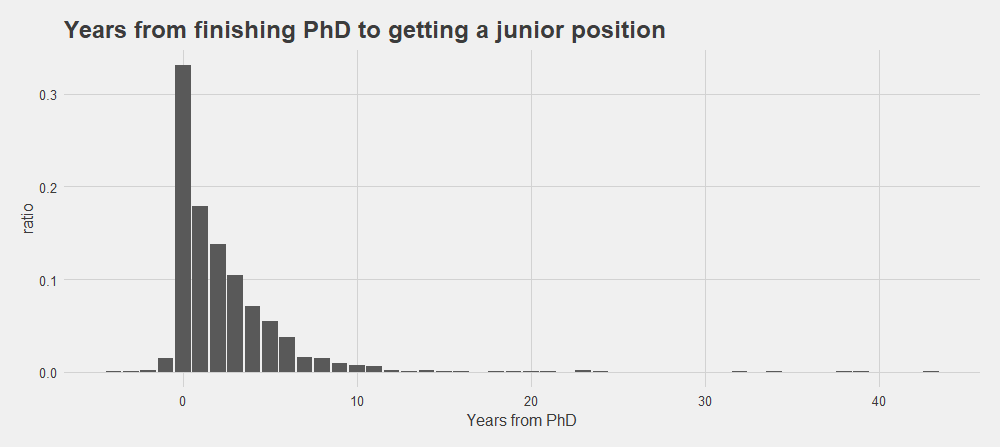
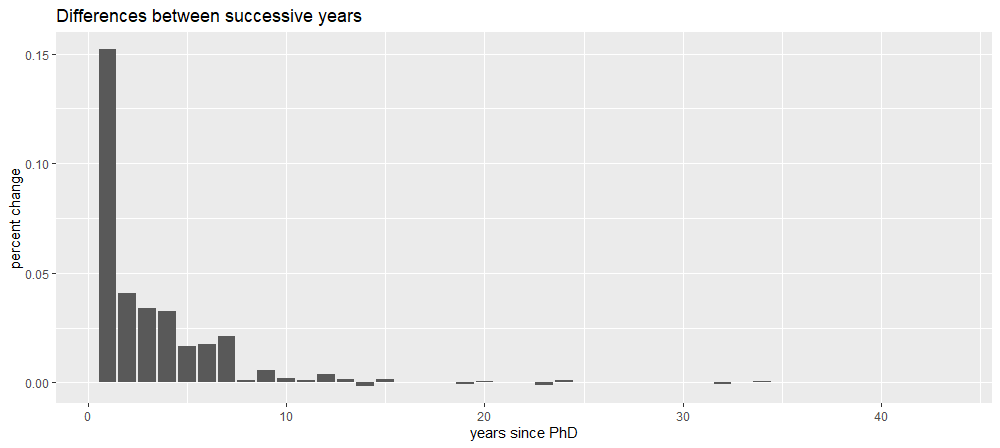
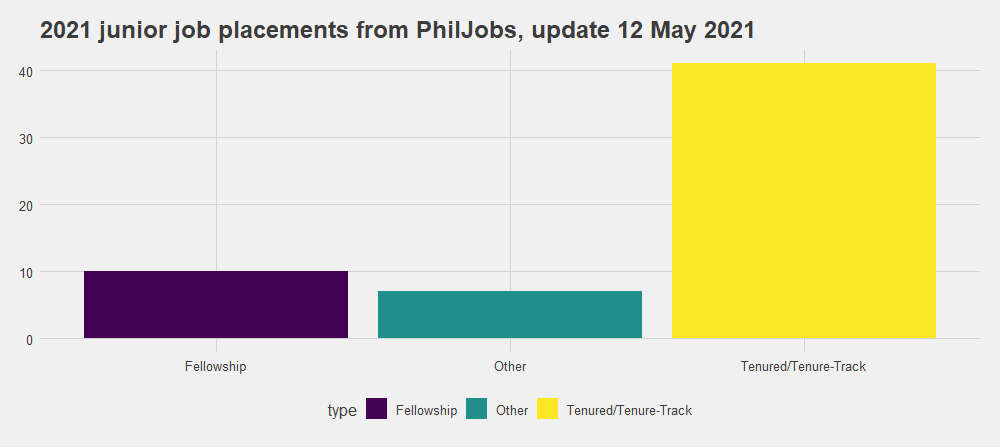
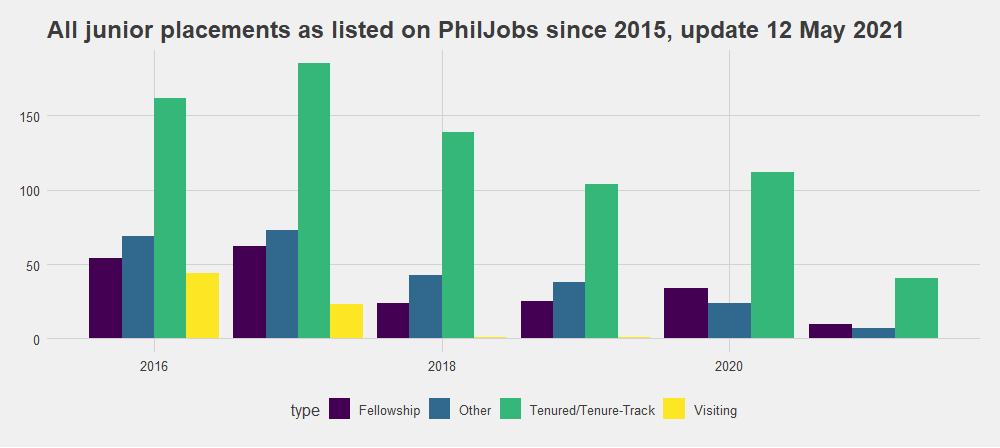
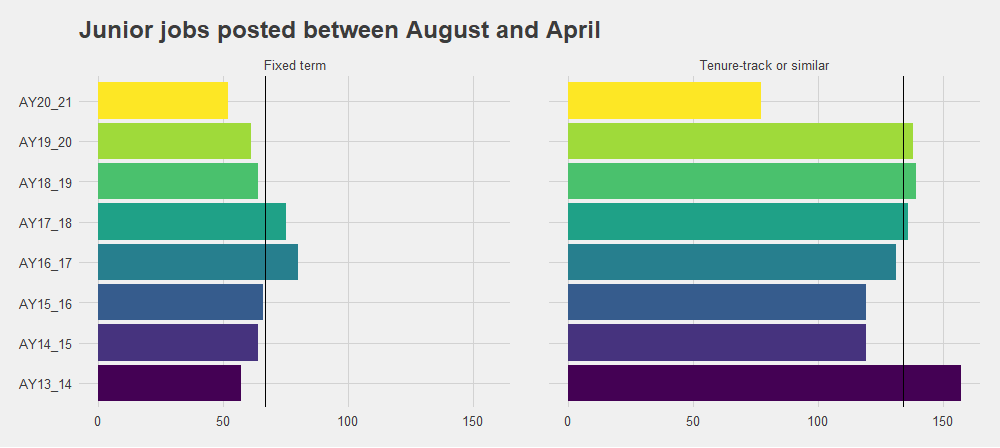
 RSS Feed
RSS Feed
